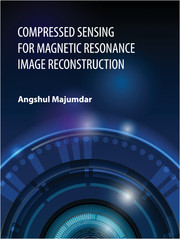Book contents
- Frontmatter
- Contents
- List of Figures
- List of Tables
- Foreword
- Preface
- Acknowledgements
- 1 Mathematical Techniques
- 2 Single Channel Static MR Image Reconstruction
- 3 Multi-Coil Parallel MRI Reconstruction
- 4 Dynamic MRI Reconstruction
- 5 Applications in Other Areas
- 6 Some Open Problems
- Index
- About the author
- Color Plates
3 - Multi-Coil Parallel MRI Reconstruction
Published online by Cambridge University Press: 05 June 2016
- Frontmatter
- Contents
- List of Figures
- List of Tables
- Foreword
- Preface
- Acknowledgements
- 1 Mathematical Techniques
- 2 Single Channel Static MR Image Reconstruction
- 3 Multi-Coil Parallel MRI Reconstruction
- 4 Dynamic MRI Reconstruction
- 5 Applications in Other Areas
- 6 Some Open Problems
- Index
- About the author
- Color Plates
Summary
In Chapter 2, we learnt how signal processing-based techniques can be employed to accelerate MRI scans. These techniques were developed after the advent of compressed sensing. Since these techniques only require changes in the sampling and reconstruction modules of the software, such methods are called software-based acceleration techniques. But prior to the development of such signal processing-based techniques, physics-based acceleration techniques were popular. Physics-based acceleration techniques change the hardware of the scanner in order to facilitate faster scans. Multi-coil parallel MRI is a classic example of physics-based acceleration.
In single-channel MRI, there is a single receiver coil with uniform sensitivity over the full Field of View (FoV). In multichannel MRI, there are several receiver coils that are located at separate locations of the scanner; consequently, they do not have a uniform FoV, for example, see Fig. 3.1. Each of the coils can only distinctly “see” a small portion of the full FoV.
In the multichannel MRI, each of the receiver coils partially samples the K-space; since the K-space is only partially sampled, the scan time is reduced. The image is reconstructed from all the K-space samples collected from all the coils. The theoretical possibility of combining multi-coil Fourier frequency samples for the purpose of reconstructing a single MR image follows from Papoulis’ generalized sampling theorem [1]. The ratio of the total number of possible K-space samples (size of the image) to the number of partial samples collected per coil is called the acceleration factor. In theory, the maximum acceleration factor is the same as the number of coils, but in practice, it is always less than that, for example, if there are 8 receiver coils, the maximum possible acceleration factor will be 8, that is, each coil will sample 12.5% of the total K-space; but in practice, each coil may sample 25% of the K-space and hence the acceleration factor will be 4 instead of 8.
For accelerating the scans, the K-space is partially sampled. There are two possibilities – one can interpolate the unsampled K-space locations, approximate the full K-space, and then reconstruct the image via inverse FFT; or one can directly recover the image from the partially sampled K-space scans.
- Type
- Chapter
- Information
- Publisher: Cambridge University PressPrint publication year: 2015
- 1
- Cited by



